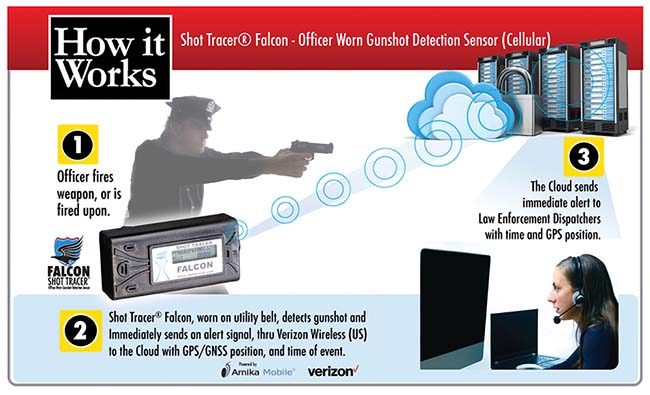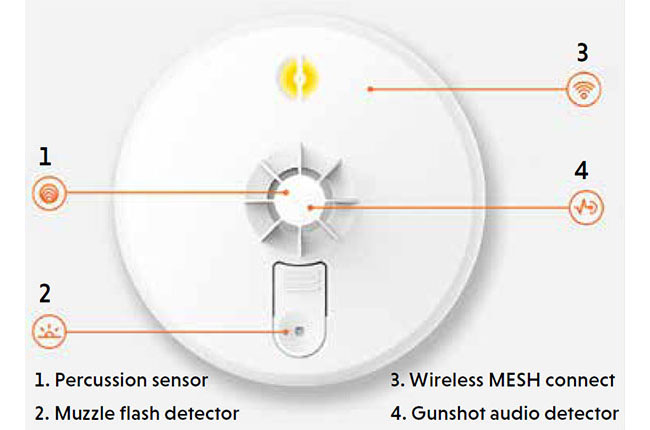For all of our many-splendored modern accomplishments man has really not advanced much farther than his primitive forebears when it comes to rending the very life from his enemies. Where our cave-dwelling precursors might have de-brained an erstwhile neighbor that was making goo-goo eyes at his comparably primitive woman with a handy rock, nowadays we just zip a carefully crafted bit of metal out to do the same job at a substantial distance. Whether the tool is an 18th century .75-caliber Brown Bess flintlock musket or an Information Age FN SCAR, the basic concept remains the same.
In modern combat the first challenge is usually finding the guy who is trying to kill you. While God gave us some remarkably effective tools to help us accomplish that mission, modern technology has now enhanced that capability substantially. To understand gunshot locating, however, we must first appreciate a spot of science.
A Quick Bit of Physics
All modern small arms accelerate a projectile to high velocity by means of an exothermic chemical reaction contained within a pressure vessel. Where the Terminator’s phased plasma rifle may indeed be just around the corner, for now it is still all just good old-fashioned guns and bullets. The detectable byproducts of this process can be broken down into three broad categories. The guns and their projectiles produce noise, there is typically some degree of muzzle flash, and the transiting bullet, if traveling faster than sound, creates a shockwave. All three of these signatures can be analyzed to localize the source of a gunshot.
The science of gunfire location was first used during World War I to identify the source of artillery fire based upon its unique sonic signature. Microphones arrayed kilometers apart would register the low-frequency report of artillery pieces firing and then, by applying a little acoustical science along with some 10th grade Euclidian geometry, estimate the location of the guns. The Germans used this technique throughout the war, while the Allies dismissed it as ineffective. A similar technique is used today, but the calculations are executed instantly by microprocessors. The end result is a remarkable new capability for civilian, corporate, law enforcement (LE) and military users.

ShotSpotter
The ShotSpotter system is employed on a neighborhood scale. More than 90 American cities currently employ the ShotSpotter. Where roughly 80% of gunfire incidents typically go unreported via traditional law enforcement means, the ShotSpotter effectively and automatically detects and localizes 90% of the gunshots within a covered area. This service has been shown to decrease overall crime rates substantially in communities both large and small.
The ShotSpotter system follows a predictable process. When a gun is fired sensors detect the sound impulse. A computer instantly triangulates the source of the gunfire. Software in the system automatically confirms the sound as gunfire and identifies details like the round count and time since trigger pull. On-duty human acoustics experts review the incident and verify that the data appears reliable. The ShotSpotter system issues an alert that can be transmitted to dispatch centers, smartphones or mobile data terminals in law enforcement vehicles. The elapsed time between trigger pull and alert to dispatch is around 60 seconds. As a result LE officers can arrive at a crime scene quickly with significantly enhanced situational awareness.
The ShotSpotter consists of a series of rooftop microphones linked into a subscription service not conceptually dissimilar to a citywide home security system. The system is monitored 24 hours a day and provides LE officers with tactical gunshot information in near real time. This data can be used to enhance timely law enforcement response and assist in evidence gathering after an event. The sensors only detect impulsive noise so there are no privacy concerns. Historical data is wiped automatically every 72 hours regardless.
Sound suppressors will degrade the effectiveness of the ShotSpotter to a slight degree, but the system nonetheless remains effective. The ShotSpotter algorithm will still detect suppressed gunshots and differentiate them from background clutter like fireworks or mechanical automotive racket. ShotSpotter data can also be integrated into existing video surveillance systems to help direct and localize surveillance assets. shotspotter.com
AmberBox Gunshot Detection
The AmberBox system is designed to operate within a commercial building. Think of the AmberBox as a smoke detector for gunshots. The system requires nothing more than electrical power, and it can see through walls. The AmberBox system includes its own built-in wireless MESH network that does not rely upon or interfere with existing data systems or electronic devices. The individual AmberBox sensors communicate through a base gateway to a centralized monitoring center. The system supports itself as a subscription service.
AmberBox sensors detect percussion, infrared signatures and acoustic reports. Data is processed and an alert automatically issued within 3.6 seconds of a gunshot. The system is configured to notify law enforcement agencies automatically in the event of a gunshot within the protected area. Line of sight to the shooter is not required, and localization accuracy is within 60 feet. Because of the bi- and tri-modal method of detection there is near zero risk of false alarms.
There is no real-time audio transmitted, minimizing privacy concerns, and installation is simple and intuitive. The sensors are unobtrusive and look very similar to conventional smoke detectors. The AmberBox system offers peace of mind and potential liability mitigation for commercial businesses both large and small. amberbox.com
Shot Tracer®
The Shot Tracer gunfire detection system operates either via a cellular telephone system or a conventional security array to provide gunshot detection on scales both large and small. Institutional Shot Tracer devices interface seamlessly within existing security systems. While the Shot Tracer system is designed to provide coverage in large corporate buildings, entertainment venues, airports, apartment complexes and schools, the Shot Tracer Falcon is a body-worn device that can substantially enhance officer survival.
The Shot Tracer Falcon rides on an officer’s duty belt and looks like a pager. The unit’s rechargeable battery charges from a charging station while off duty. The device has a 10-meter range and automatically detects gunfire from 9mm weapons on up. The Shot Tracer Falcon automatically reports an officer’s location, the number of shots fired and the time of discharge.
A manual panic button triggers an alert under circumstances wherein radio communication might not be practical. The system responds to both gunshots and explosions. The Shot Tracer Falcon can interface through a conventional cellular network or via the Iridium satellite system. The Shot Tracer Falcon allows the isolated law enforcement officer to focus on the gunfight rather than his or her radio. shottracer.com

Shooter Detection Systems
Shooter Detection Systems (SDS) offers gunfire detection equipment for applications both indoors and out. The SDS Guardian is a fully automated gunshot reporting system that installs unobtrusively. Gunfire information is plotted on a building schematic for responding agencies. The system can be configured to produce instantaneous mass text alerts notifying employees of an active shooter situation. As there are no humans in the loop, response time from trigger pull is almost instantaneous. With 26 million operational hours logged, Shooter Detection Systems has maintained a perfect 100% detection rate along with zero false alerts.
The SDS Boomerang uses acoustic detection and computerized signal processing to instantly locate small arms fire and report the source to users or authorities. The Boomerang can be mounted on fixed structures like walls or poles, moving vehicles or even a human shoulder. Boomerang systems were designed from the outset to easily integrate into third-party systems to become an integral part of a comprehensive site security plan. shooterdetectionsystems.com

Ultra Electronics’ Rifle-Mounted Gunfire Locator
The Rifle-Mounted Gunfire Locator (RMGL) from Ultra Electronics seems the stuff of science fiction. This compact unit weighs 1 pound with batteries and mounts on the standard Picatinny rail of a host Infantry rifle. By analyzing the acoustic data of incoming small arms fire the RMGL instantly calculates the range, direction and elevation back to the source. Target data is displayed on a small OLED screen. An onboard inertial compensation system continually updates to track the movement of the host rifle. The system quickly and accurately directs the weapon back toward the source of the gunfire despite limited visibility or battlefield obscurants. Such capabilities were literally unimaginable a generation ago.
The RMGL is NVG compatible, and its intuitive control system consists of only two buttons. There are no loose cords to catch on things, and the unit is rugged and fully weatherproofed. Detection range is between 30 and 1,200 meters. The system filters out both false alarms and outgoing fire. The target position updates 10 times per second, and the RMGL operates seven hours on a standard pair of AA batteries. The system has been proven effective against everything from 5.56mm up to .50BMG.
The sighting unit offers a simple clock face pointer for coarse orientation as well as cross hairs for tweaking azimuth and elevation. The numbers of events detected and range to target are both displayed on the hardened screen. The system includes a self-test function and simple menu-driven options.
Like any military or law enforcement weapon, there is a learning curve to operate the RMGL, but it remains fairly shallow. From an idle position the display shows only a simple black screen with a dot in the center. When alerted to hostile fire the unit produces a large arrow that cycles around the display as the soldier or police officer indexes toward the threat. Once the weapon is grossly oriented toward the target the display shifts to a pair of perpendicular index lines. The operator then simply moves the weapon in both azimuth and elevation until the two lines are centered and squeezes the trigger. The system automatically calculates a return fire solution that is +/- 5 degrees in both azimuth and elevation and within a 15% error in range.
The RMGL can be used in static and forward operating bases, on naval craft both large and small, from within helicopters and mounted atop individual Infantry weapons. This technology substantially enhances situational awareness, facilitates threat neutralization and saves friendly lives. The RMGL is a proven system that takes up remarkably little space. The device looks a bit like a miniature Death Star perched atop a typical Infantry rifle. As a result, operational users have come to call the device the “Sniper’s Egg.” The RMGL is one of the most significant advances in military counter-sniper operations ever conceived. ultra-fei.com

Ruminations
The greatest benefit to the operational use of a sound suppressor on an individual combat weapon is not to make the weapon silent. It is to cause the firearm to sound like something other than a gun and mask the direction of fire. Supersonic bullets still produce a striking sonic crack, but it becomes literally impossible to localize the direction of the suppressed gunshot using nothing but a pair of human ears. These sundry high-tech devices change all that.
By analyzing the salient attributes of the sound, shock and flash produced by a firearm and its projectiles these systems will quickly identify the threat and plot its location. These devices operate much more quickly and accurately than human senses alone. These products can potentially identify the location and nature of the threat, summon help and even immediately direct suppressive fire. By harnessing the power of microelectronics along with instantaneous information management, these devices provide powerful new tools to the business leader, military commander, LE officer or individual grunt downrange. The end result is a populace that is safer, LE agencies that are more responsive, forces that are more survivable and individual combatants that project enhanced lethality.
Some of this tech is relatively cheap. Some of it is spendy. All of it is revolutionary. By applying the science of physical acoustics to the thorny problem of gunfire location we open a brave new world in tactical capabilities. The practical possibilities are spellbinding.











